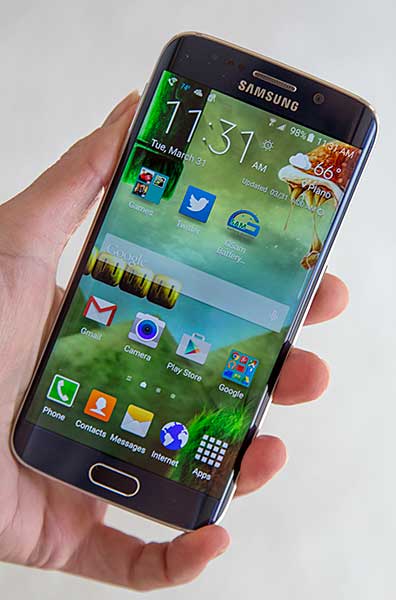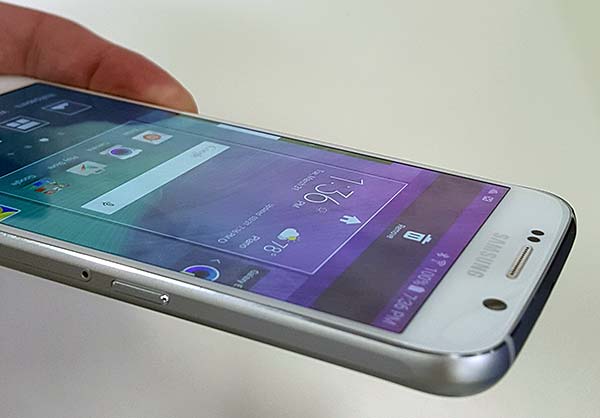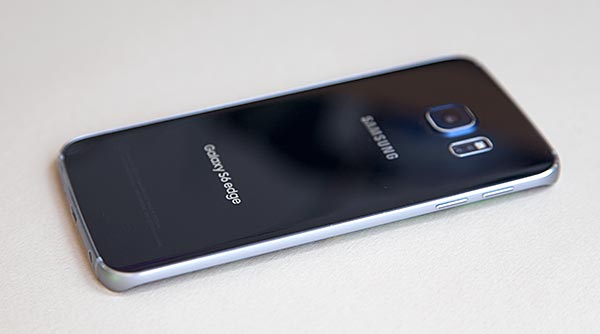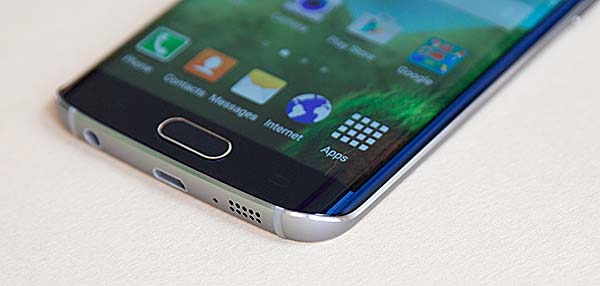|
It's a brave new world where reviewers and high-end hardware lovers will no longer lament or mock the latest Samsung Galaxy's plasticky looks. Both the Samsung Galaxy S6 and the curved-sided Galaxy S6 Edge are class acts with Gorilla Glass 4 front and back and a matte aluminum (real metal not the faux stuff) frame. Samsung has finally found a design to match their compelling plethora of top specs and high tech features. Granted, the more traditionally designed GS 6 looks an awful lot like the iPhone 6 from the bottom, sides and even front, but it's changed things up enough to have its own personality. The Samsung Galaxy S6 Edge on the other hand is certainly unique and futuristic looking with glass that curves around the left and right sides. It's a beauty, and that set of curves will cost an additional $100 over the standard GS6. You're paying for the looks here since the side display doesn't add much functional value, unlike the Samsung Galaxy Note Edge's useful edge display.
The chic unibody design comes at a cost that Apple, Sony and HTC have already faced: there's no way to incorporate a removable back so the battery is sealed inside. Those of you who love swapping in a spare battery will have to switch to external micro USB charging packs when on the go. Samsung also axed the microSD card slot (HTC and Sony managed to preserve it, so what gives Samsung?). As a consolation, you can order the Galaxy S6 and S6 Edge with 32, 64 or 128 gigs of storage. Of course a 128 gig GS6 Edge is a frightening $960, a price that could get you a top-notch Intel Core i5 Ultrabook. Since all 4 major US carriers now offer payment plans, they're hoping that the high retail price won't scare you away.

The Galaxy S6 siblings run on the Samsung Exynos 7420 octa-core CPU with 3 gigs of RAM and your choice of internal storage. We don't usually see the Exynos variant of Samsung phones here in the US where the Qualcomm Snapdragon line owned the LTE chipset market but recent anti-trust grumblings against Qualcomm may have opened up LTE technology to other chip makers like Samsung. For those of you who aren't wildly geeky: smartphones use a SoC (system on chip) architecture where the CPU, graphics and LTE wireless radio are combined in one package. Clearly Samsung can optimize the handset better if it makes the hardware and can customize the OS, and it's paid off here.
The phone has dual band WiFi 802.11ac, Bluetooth 4.0, NFC and fast CAT 6 LTE 4G (multi-spectrum, 300 Mbps). It will be available on all major and several smaller carriers, and different model variants will support different cellular voice and data bands. It has an AV remote control, heart rate monitor, 5MP front camera, rear 16MP camera with OIS, and a much improved fingerprint scanner. Unlike older Galaxy models and PC laptops where you swiped your finger over the scanner and prayed, this one works like the iPhone 6: rest your finger on the home button and press down. It works 99% of the time, just like the iPhone!
A Super AMOLED Display that's Super
The 2015 Galaxy S6 models have striking 2560 x 1440, 577 PPI Super AMOLED displays (that's the same resolution as the Note 4 display). Arguably, when pixel density moves from the 400's to the 500's as with the S6 from the Samsung Galaxy S5, only those of you with microscope eyes will readily perceive the difference, but Android is always about specs wars. That said, the S6 and S6 Edge have the best looking AMOLED displays on the market: they're very bright (particularly on auto-brightness), have good color fidelity, superb saturation and deep blacks. They're supremely sharp and you won't see any of that AMOLED color fringing on text. The curved model has an infinity pool look that's stunning. Yes, light can refract at the apex of each curve, but that's the nature of glass and light. There's no distortion or problem of any sort here and the phone ignores your palms when you're holding the phone, so you won't accidentally tap on something.

Feeling Edgy
Unlike the Samsung Galaxy Note Edge, the side display (or displays in the case of the GS 6 Edge) aren't addressed as separate display panels. That allows you to select either side as your edge display, but it also means that there's nothing truly autonomous of the main display going on here. The side display can display a list of your favorite contacts (grab the tiny tab on the side of the display and pull toward the center to reveal the contacts strip so you can quickly contact someone via voice or messaging). The side will glow with the color of the contact who's calling (you assign a color to each favorite contact) and the phone can vibrate when you pick it up if you've missed a call. The remaining edge panels come into play when the phone is sleeping and the display is off. You'll have to swipe back and forth along the length of the edge to bring up the edge panels: stock ticker, missed calls and message notifications, sports scores and RSS feeds. It can act as a bedside clock for up to 12 hours per day based on a schedule that you set. There's no app launcher as with the Galaxy Note Edge (one of our favorite uses of the edge display), nor does the side edge offer a spot for app menus or controls like the Note Edge. Honestly, you're paying for the curved glass look with the GS 6 Edge rather than improved functionality.

Brightness on both the GS6 and GS6 Edge can reach 600 nits, but only with auto-brightness enabled. If you're using manual brightness as I tend to do since auto-brightness sets the display dimmer than I like for indoor use, then you'll get just under 300 nits of brightness. Clearly, Samsung wants to prevent undue battery drain by mandating auto-brightness for max brightness, and that 600 nit mode does look a bit distorted, since contrast and brightness are overwrought. It works fine to combat bright direct sunlight, but you wouldn't want to use it indoors or in heavy shade, so we can understand by Samsung prevents you from manually driving the display in that mode all the time.
Performance and Horsepower
Samsung's Exynos CPUs have been strong performers, but charging speeds and runtimes have sometimes fallen short of competing Snapdragon CPUs. The 14nm Exynos 7420, like the new 20nm Snapdragon 810, is an 8 core, 64 bit CPU. Also like the Snapdragon and recent NVIDIA Tegra CPUs, it uses a big.LITTLE architecture with 4 low power cores to handle less demanding tasks and 4 high power cores to handle more CPU intensive tasks like gaming and rendering rich web pages. Thus a maximum of 4 cores can be active at one time, and it uses the same ARM Cortex A53 + Cortex A57 core architecture as the 810. Samsung runs the chips at a wee bit faster clock speed and the A57 cores are clocked at 2.1 GHz while the A53s are clocked at 1.5 GHz. The S6 models have Mali T-760 MP8 graphics, which benchmarks well and plays games wonderfully. Is the Exynos 7420 fast? Yes! It surpasses the Snapdragon 810 in some benchmarks, and honestly both are much faster than necessary for most tasks. If the Galaxy S6 feels slower or faster than the HTC One M9 or even the Nexus 6, it's more likely due to OS and software optimization rather than the CPU.

The speed improvements don't stop with the CPU and GPU though. The Galaxy S6 and S6 Edge use fast UFS 2.0 storage and LPDDR4 RAM. UFS 2.0 is nearly 3 times faster than the eMMC storage used in most smartphones to date. That translates into faster game load times (since games tend to load lots of graphics and sound bytes) and faster video capture times, which is important when you have 4K video recording on board.
Benchmarks
| |
Quadrant |
3DMark Ice Storm Unlimited |
AnTuTu |
Sunspider JavaScript Test (lower is better) |
| Samsung Galaxy S6 |
33,355 |
21,160 |
61,873 |
420 (webkit)/1025 (Chrome) |
| Samsung Galaxy S5 |
23,643 |
18,329 |
35,357 |
398 |
| Samsung Galaxy S6 edge+ |
34,422 |
24,397 |
64,059 |
349 (Webkit)/692 (Chrome) |
| Samsung Galaxy Note 5 |
34,631 |
24,463 |
63,086 |
351 (Webkit)/688 (Chrome) |
| Samsung Galaxy Note 4 |
24,327 |
19,667 |
46,912 |
425 |
| HTC One M9 |
33,733 |
22,168 |
53,582 |
852 |
| LG G4 |
23,730 |
18,655 |
46,043 |
760 |
| LG G Flex 2 |
26,390 |
22,644 |
49,344 |
730 |
| LG G3 |
24,385 |
18,708 |
36,525 |
425 |
| Nexus 6 |
13,595 |
23,520 |
49,961 |
795 |
| Motorola Droid Turbo |
22,709 |
20,735 |
48,332 |
795 |
| Moto X (2nd gen) |
22,170 |
19,924 |
44,340 |
776 |
| HTC One M8 |
24,527 |
20,896 |
36,087 |
776 |
| Sony Xperia Z3 |
21589 |
16,135 |
35,008 |
837 |
| Nexus 5 |
8808 |
17,828 |
27,017 |
718 |
| LG G2 |
19,762 |
9803 (extreme) |
32,990 |
823 |
| Samsung Galaxy S4 |
12,276 |
11,601 |
24,776 |
826 |
Geekbench 3: 1454/4619
|
Deals and Shopping:
Advertisement
|

